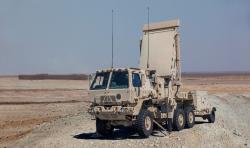Releases

SYRACUSE, N.Y., Oct. 8, 2018 – The U.S. Army awarded Lockheed Martin a contract modification to insert Gallium Nitride (GaN) into the AN/TPQ-53 (Q-53) radar as part of the full rate production configuration.
The Q-53 is the most modern radar in the U.S. Army inventory and has the flexible architecture to address aircraft, drone and other threats in the future. The transition to GaN will provide the Q-53 with additional power for capabilities including long-range counterfire target acquisition. GaN has the added benefit of increasing system reliability and reducing lifecycle ownership costs.
“Lockheed Martin is proud the Army is adding Q-53 to our family of fielded GaN based radars,” said Rick Herodes, director of the Q-53 program at Lockheed Martin. “This modification takes advantage of our broad experience with radar production and next generation radar development experience coupled with Lockheed Martin’s continuous investment in GaN and other radar technologies. This update enables Q-53 mission growth for changing Army needs. We realize how critical it is to enhance the capabilities of the Q-53 so it can be responsive to the evolving operational demands and emerging threats our deployed troops face every day.”
For more than 10 years, Lockheed Martin has used an open GaN foundry model leveraging relationships with commercial suppliers that utilize the power of the expansive telecommunications market. This process eliminates the cost of foundry operations, takes advantage of the telecommunications industry’s investment in GaN, enables competition and ultimately reduces costs.
The primary mission of the multi-mission Q-53 is to protect troops in combat by detecting, classifying, tracking and identifying the location of enemy indirect fire in either 360 or 90-degree modes. Mounted on a five-ton truck, the Q-53 can be rapidly deployed, automatically leveled then operated remotely or from a command vehicle with a laptop computer. The radar is software defined allowing for quick adjustment to address emerging Army capability needs for air surveillance and counter fire target acquisition.
The Q-53 has protected warfighters around the world since 2010.
Lockheed Martin currently produces multiple Q-53 radars annually. Work on the system is performed at Lockheed Martin facilities in New York, New Jersey and Florida.
For more information visit https://www.lockheedmartin.com/en-us/products/tpq-53.html.

